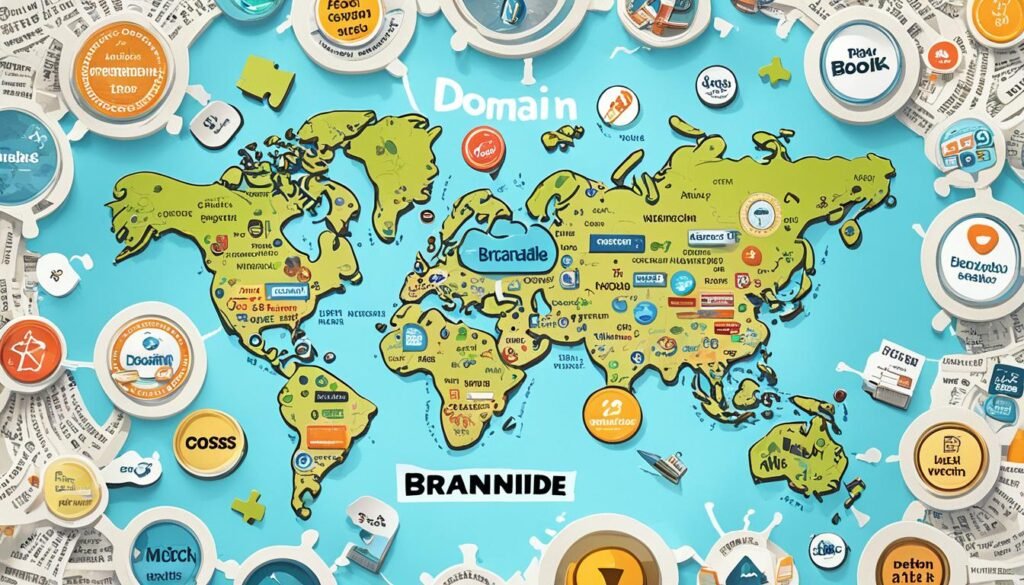Whether you’re launching your first business, seeking to enhance your market presence, or engaging in personal online ventures, the quest for an ideal domain name is paramount. This article serves as a definitive manual on acquiring domains. It delves into the precise process of procurement, evaluates premier domain registrars, and offers in-depth insights on domain names.
Our exploration of domains is engineered for clarity, embracing an accessible tone while addressing crucial subjects like domain types and the art of registration. It equips you with the knowledge required to demystify domain names, from the rudiments to advanced acquisition methods. By journey’s end, you’ll be well-versed in navigating the domain name arena, poised for both initial and subsequent acquisitions.
Key Takeaways
- This article will teach readers how to buy a domain name, regardless of their background.
- The guide will cover the steps involved in purchasing a domain, review top domain registrars, and provide a comprehensive understanding of domain names.
- The content will unravel the mysteries of domains, covering topics like domain types, registration, and how to choose the perfect domain for your website.
- Readers will learn to navigate the domain name landscape, from understanding the basics to the step-by-step process of purchasing a new domain or acquiring an already registered one.
- The article aims to provide all the necessary information to successfully buy and manage a domain name for your online presence.
What is a Domain Name?
A domain name stands as the digital entry point to a website online. It marks an integral piece of a website’s digital presence, offering a straightforward and memorable avenue for users to discover and engage with online destinations. Prior to the advent of the Domain Name System (DNS) in 1983, online navigation was daunting; users memorized numerical IP addresses to reach websites.
Defining a Domain Name
The domain name definition hinges on a distinct string of characters constituting a website’s address, for instance, “kinsta.com.” This alias simplifies the task of website access, enabling visitors to input the domain name into their browser, bypassing intricate IP addresses.
The Role of Domain Names in Digital Presence
Domain names are pivotal for a website’s digital presence, serving as a cornerstone of its branding and online identity. A carefully-selected domain name can elevate a site’s searchability, memorability, and credibility, facilitating user interaction with the platform’s content or services.
The Evolution of Domain Names
The narrative of domain names dates to the internet’s nascent stages, when they were peripheral to the online world. Yet, with the internet’s evolution, domain names emerged as a critical facet of a website’s unique identity, transcending technical necessity to a crucial strategic assest for achieving digital success.
How Domain Names Work
The domain name system (DNS) is essential for internet domain functionality. Users input a domain name into their browser. This action triggers a request through a global network of DNS servers.
These servers then transform the domain name into the corresponding IP address. Essentially, it functions as a digital phonebook. It links the familiar domain name to the precise numerical address of the website’s server.
Name Servers and DNS Servers
Once the correct IP address is identified, the data is sent to the name servers. These servers are in charge of maintaining the domain’s information. They guide the user’s browser to the appropriate web server. This server holds the website’s files and content.
This handoff ensures users can reach websites by entering a memorable domain. Without this system, deciphering long strings of numbers would be necessary to access sites.
The Web Server’s Role
The web server is vital in the domain name system. It serves the website’s data directly to the user’s browser. Once the correct web server is determined, the browser fetches the essential files.
Thus, users can view and interact with the website content. This orchestrated operation between the DNS, name servers, and web servers makes internet navigation reliable and straightforward.

Differences Between Domain Names, Websites, and Web Hosting
Comprehending the pivotal roles of domain names in the virtual realm necessitates a clear distinction between domain names, websites, and web hosting. A domain name serves as the exclusive digital locator for websites, like “example.com.” It is imperative to recognize that a domain name does not embody the website itself.
Understanding Websites
The website constitutes an amalgamation of web pages, visuals, video clips, and miscellaneous digital assets that forge an organization’s web visibility. These components serve as the interactive interface for visitors upon arriving at a website through its domain name.
The Function of Web Hosting
Web hosting exteriorizes as the underpinning that allocates physical server space for storing and disseminating the constituents of a website. As entities tasked with furnishing server capacity, bandwidth, and pertinent resources, web hosting providers are instrumental in making a website overtly accessible to denizens of the internet.
Separating Domain Names and Web Hosting
Though domain names and web hosting proffer distinct functions, their confluence is essential for effective web deployment. The domain name operates as the navigational beacon, directing users to the web hosting provider’s servers housing the website’s data. This interspersion is critical for the establishment of a viable online platform.
Types of Domain Names
Domain name types encompass various categories that significantly influence a website’s online presence and brand perception. Familiarization with TLD, ccTLD, sTLD, new gTLD, and SLD selections is pivotal for informed domain name decisions. This understanding is critical, especially for business or personal project branding.
Top-Level Domains (TLDs)
Top-Level Domains (TLDs) are the prevalent extensions at a domain name’s conclusion, including .com, .org, and .net. Notably, the .com extension is globally favored across business and individual web domains, rendering it as the premier domain name type.
Country Code Top-Level Domains (ccTLDs)
In stark contrast, Country Code Top-Level Domains (ccTLDs) link quite closely to specific nations or territories. For instance, .uk for the United Kingdom, .de for Germany, and .jp for Japan. The ccTLD choice often plays a pivotal role in local market targeting or showcasing the website’s regional essence.
Sponsored Top-Level Domains (sTLDs)
Sponsored Top-Level Domain (sTLD) provides designated internet space for unique user communities or organizational sectors, like .edu for educational entities and .gov for government bodies. Through these sTLD categories, a web user instantly discerns a site’s specific field or mission.
New Generic Top-Level Domains (New gTLDs)
In more recent times, New Generic Top-Level Domains (New gTLDs) have introduced an expansive array of niche-specific domain extensions. Unlike the conventional .com, .org, or .net, these new gTLD options offer more targeted domain naming possibilities, such as .photography, .pizza, or .club.
Second-Level Domains (SLDs)
Moving further, the Second-Level Domain (SLD) delineates the text component before the TLD within a domain name. For instance, in “example.com,” “example” serves as the defining component, representing the website’s brand or owner.

The Internet Corporation for Assigned Names and Numbers (ICANN)
The Internet Corporation for Assigned Names and Numbers (ICANN) serves as a non-profit organization at the helm of the domain name management system. This entity establishes policies for ICANN and oversees the delegation of authority to Domain Name Registrars. These registrars are thereby enabled to engage in the selling and administration of domain names.
In its capacity, ICANN governs the worldwide coordination of the Domain Name System (DNS), safeguarding the internet’s addressing architecture. The institution’s paramount charter involves the regulation and stewardship of the domain name sector. By doing so, it ensures the efficient operation of domain names for every global internet user’s benefit.
| Key Responsibilities of ICANN | Impact on Domain Name Management |
|---|---|
| Establishing domain name policies and guidelines | Ensures consistency and fairness in the domain name ecosystem |
| Accrediting and managing domain name registrars | Ensures reliable and secure domain name registration services |
| Overseeing the Domain Name System (DNS) | Maintains the stability and integrity of the internet’s addressing system |
| Facilitating the introduction of new Top-Level Domains (TLDs) | Expands the domain name options available to users and businesses |
As the preeminent arbiter of domain name management globally, ICANN assumes a pivotal function. It works to influence and direct the domain name industry, fostering its growth and adaptive evolution for the benefit of the planet’s internet populace.

Choosing the Right Domain Name
Constructing a formidable online presence starts with selecting a domain name wisely. This choice is the initial point of contact between a brand and its audience. Opting for a name that is both resonant and indicative of your entity is therefore paramount. We will delve into essential criteria for choosing the perfect domain name.
Sticking with a .com Domain
In today’s dynamic web landscape, the significance of the ubiquitous .com domain remains steadfast. Its prevalence continues to elevate its credibility, making it the establishment’s extension of choice. Primarily, this affirms your endeavor as trustworthy in the eyes of netizens, bolstering your digital foothold.
Keeping It Short and Memorable
Choosing a succinct and easily memorized domain name is advised. Brevity enhances memorability and typographical accuracy, facilitating user access and recall. A streamlined title promotes both visibility and navigational ease within the digital sphere, benefitting your online traffic and engagement.
Avoiding Numbers and Hyphens
In deciding on the domain name composition, eschewing numbers and hyphens is wise. These entities dilute a name’s succinctness and mnemonic value, complicating recall. The ensuing difficulty in spelling and memorization poses an obstacle to prospective user engagement and brand identification, underscoring the detriment of such choices.
Using Domain Name Generators
Integration of online domain name generators can be instrumental in overcoming naming impasses. This tactic broadens the scope of potential, sifting through myriad unused, creative options. Such tools circumvent the challenge of saturation, enabling the discovery of distinctive and memorable alternatives for your domain.

Domains
Embarking on the path towards securing a domain name is a pivotal endeavor for those journeying into digital landscapes. Be it for the initiation of a novel venture, a platform that reflects one’s personal ethos, or the fortification of an established identity, the process unveils layers of requisite insights. Mastery over domain registration methodologies, familiarity with esteemed domain registrars, and vigilance regarding the dynamic milieu of domain economics and renewal exigencies truly augments one’s capacity for strategic and efficacious domain procurement.
Registering a Domain Name
The initial foray into domain registration commences with aligning oneself with an ICANN-accredited entity. These distinguished organizations possess the authority to vend and administrate the namesake of digital presences, crafting a realm of certainty and trust for the user. Prominent figures in the domain of registration, namely GoDaddy, Namecheap, and Bluehost, proffer an array of solutions intended to meet the divergent and nuanced requirements of custodians of virtual realms.
Popular Domain Registrars
Elections pertinent to domain registrar selection necessitate evaluation of factors such as the quality of client support, availability of ancillary provisions (inclusive of web hosting or email services), as well as the total expenditure associated with enrolling and sustaining ownership of a domain. Divergence in the cost framework and operational guidelines amongst registrars underscores the imperative need for a meticulous assessment, ensuring congruence between the selected registrar’s offerings and the aspirant’s stipulations.
Domain Pricing and Renewals
The financial outlay attendant to a domain name acquisition typically spans a bracket of $10 to $20 on an annual basis. Variations within this range are predicated upon the domain extension, the registrar’s pricing schema, and the applicability of promotional concessions. It bears paramount significance that the onus of domain registration upkeep rests with the proprietor, necessitating prompt action upon expiration to preclude the forfeiture of title. Diligent calendar management and vigilance towards the renewal calendar are imperatives for the uninterrupted vitality of one’s digital foothold.
Buying a Taken Domain Name
Acquiring a registered domain poses challenges. However, navigating the process with sagacity ensures success. Essential to this endeavor is a profound understanding of domain ownership’s intricacies.
Identifying the Owner
Initiating the purchase of a registered domain mandates owner identification. A domain lookup tool is pivotal, unveiling registration particulars and the owner’s contact data. When the domain is underuse, or with a trader, enlisting a broker becomes imperative for negotiation.
Hiring a Broker
A domain acquisition process maestro, the broker, expedites matters. With expertise in domain ownership identification, they ease negotiation complexities. Moreover, they guide in formulating a compelling offer sure to entice the seller.
Making an Offer
Bolstered by a broker, presenting an irresistible offer to the domain’s custodian is advised. The offer’s foundation rests on a comprehensive valuation; age, SEO stature, and any associated web assets are pivotal. Usage of a mainstream payment system, avoiding volatile cryptocurrency, is preferred to mitigate transactional disputes.
Signing a Contract
With terms agreed upon, a comprehensive contract is indispensible. This document, paramount for both parties’ protection, entails a detailed purchasing agreement. It verifies the purchase price, delineates the transferal methodology, and stipulates any preconditions for satisfaction.
Transferring the Domain
Executing the domain transfer marks the procurement’s denouement. This step necessitates registrar liaison for domain liberation. Ensuring procedural adherence is crucial for an uneventful transition, safeguarding your online property from repercussions.
Buying a New Domain Name
Initiating the process of acquiring a new domain demands careful selection of an esteemed and ICANN-accredited domain registrar. These entities orchestrate the domain registration intricacies, ensuring the seamless establishment of your domain. When electing a registrar, it is paramount to evaluate their fee models, the breadth of supplementary services, and the transcendence of their domain transfer protocols.
Choosing a Domain Registrar
The domain registration sphere is populated with distinguished entities such as GoDaddy, Namecheap, and Bluehost, each presenting an extensive panoply of domain registration options. These platforms also facilitate the acquisition of numerous domain iterations, including .com, .net, and .org, safeguarding your brand and optimizing customer navigability to your online footprint.
Following the Checkout Process
Subsequent to registrar selection, the domain checkout process necessitates the stipulation of your preferred domain name and top-level domain (TLD), an input of personal and financial details, and the finalization of the registration. It is imperative to meticulously scrutinize all facets of the transaction, notably the domain’s initial term, to guarantee an unimpeded domain ownership journey.
Registering and Setting Up the Domain
Finalizing the domain registration mandates the configuration of your domain’s name servers and hosting, a pivotal stage that renders your website attainable online. Through this undertaking, your domain name becomes associated with the server housing your website’s data, facilitating visitor discovery and access to your digital edifice.
The Importance of Domain Privacy
In contemporary domain naming spheres, domain privacy—alternatively termed “WHOIS privacy”—stands as a pivotal consideration for astute proprietors. It shields the personal data of domain holders from public exposure, a critical benefit for entities and small-scale ventures endeavoring to uphold online confidentiality.
Presently, various esteemed domain registrars introduce domain privacy as an opt-in feature, often at a nominal fee. This provision is especially advantageous for those keen to conceal their personal particulars, including their appellation, residence, and telephonic coordinates, from the general public.
The vital role of domain privacy exceeds mere functionality; it serves to forestall unsolicited inquiries, spam, and neoteric forms of cyber malfeasance arising from the unfettered accessibility of personal data online. Through safeguarding their WHOIS data, domain custodians garner tranquility to devote themselves fully to their digital ventures, assuring an absence of undesirable scrutiny or disruption.
Subdomains and Their Usage
Subdomains play a crucial role in the organization of websites. They allow for a structured web presence. A subdomain functions as a child domain under the primary domain, seen in examples like “videos.wpbeginner.com.” Third-level domain names enable the segregation of various website sections or content types. This separation simplifies navigation and access to specific site areas.
They are beneficial for numerous activities. This includes hosting separate blogs, forums, or sections for online sales. They are also ideal for generating unique pages for marketing or specific products. The use of subdomains helps in improving user interaction, increasing brand visibility, and organizing digital content better.
Subdomain usage transcends website architecture. It serves branding and marketing goals as well. For instance, a business might utilize “support.example.com” to offer a centralized customer service experience. Or they may use “careers.example.com” to present employment opportunities and entice candidates.
| Subdomain Examples | Purpose |
|---|---|
| blog.example.com | Hosts the company’s blog |
| shop.example.com | Dedicated e-commerce section |
| help.example.com | Customer support and documentation |
| careers.example.com | Recruitment and job postings |
As the potential of subdomains is further realized, digital stakeholders will likely discover more creative applications. These may include improved user interaction, enhanced brand identity, and the efficient management of complex website structures.
Conclusion
In concluding this extensive discourse on grasping and procuring domains, one understands their pivotal role in forging a robust online footprint. This adage holds true for emerging businesses, seasoned marketers, or individuals aspiring to carve out their online niche. Throughout our discussion, we’ve meticulously dissected the anatomy of domain names, ranging from their fundamental definition to the diverse categories and the acquisition methodologies. Equipped with this arsenal of knowledge, the labyrinth of domain names can now be expertly navigated.
The saga of digital eminence heavily leans on the choice of domain names and the processes surrounding their selection and acquisition. With insight into these vital aspects, one lays a fortified groundwork for realizing their digital aspirations. The central message of the domain name guide summary underscores the potent impact a well-selected domain name bears on your digital facade’s reception and discoverability amongst your audience.
Should your expedition lead to domain registration or an acquisition, pivotal strategies and contemplations have been proffered to elevate your digital landscape. Tailored counsel, from engaging with ICANN-accredited registrars to the underlined significance of domain privacy, aids in a more informed and strategic approach. Armed with this newfound wisdom, your pursuit for the ideal domain is now enriched. Keep the insights drawn from this domain name guide summary close, leveraging them for a resilient and triumphant digital trajectory.
